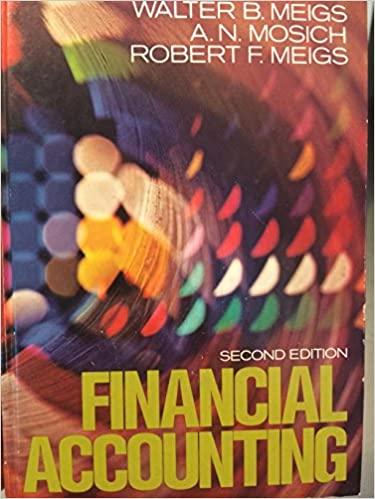c9-8



RUNDLE COMPANY Balance Sheets As of December 31 2019 2018 $ 22,000 21,200 53,000 138,000 27,000 261,200 27,000 270,000 30,000 $588,200 $ 18,000 7,200 45,000 146,000 12,000 228,200 20,000 255,000 25,000 $528,200 Assets Current assets Cash Marketable securities Accounts receivable (net) Inventories Prepaid items Total current assets Investments Plant (net) Land Total assets Liabilities and Stockholders' Equity Liabilities Current liabilities Notes payable Accounts payable Salaries payable Total current liabilities Noncurrent liabilities Bonds payable Other Total noncurrent liabilities Total liabilities Stockholders' equity Preferred stock, (par value $10, 4% cumulative, non-participating; 7,000 shares authorized and issued) Common stock (no par; 50,000 shares authorized; 10,000 shares issued) Retained earnings Total stockholders' equity Total liabilities and stockholders' equity $ 31,800 133, 800 21,000 186,600 $ 13,500 120,000 15,000 148,500 100,000 27,000 127,000 313,600 100,000 22,000 122,000 270,500 70,000 70,000 134,600 274,600 $588,200 70,000 70,000 117,700 257,700 $528, 200 2018 $330,000 7,400 337,400 RUNDLE COMPANY Statements of Income and Retained Earnings For the Years Ended December 31 2019 Revenues Sales (net) $350,000 Other revenues 10,400 Total revenues 360,400 Expenses Cost of goods sold 175,000 Selling, general, and administrative 67,000 Interest expense 11,600 Income tax expense 83,000 Total expenses 336,600 Net earnings (net income) 23,800 Retained earnings, January 1 117,700 Less: Preferred stock dividends 2,800 Common stock dividends 4,100 Retained earnings, December 31 $134,600 139,000 62,000 10,800 82,000 293,800 43,600 81,000 2,800 4,100 $117,700 2019 2018 a. Working capital b. Current ratio C. Quick ratio d. Receivables turnover times times e. Average days to collect accounts receivable days days times times days days % % f. Inventory turnover g. Average days to sell inventory h. Debt to assets ratio i. Debt to equity ratio j. Number of times interest earned k. Plant assets to long-term debt I. Net margin m. Asset turnover times times % % n. Return on investment % % 0. % % per share per share Return on equity p. Earnings per share 9. Book value per share r. Price-earnings ratio Dividend yield per share per share S. % %









